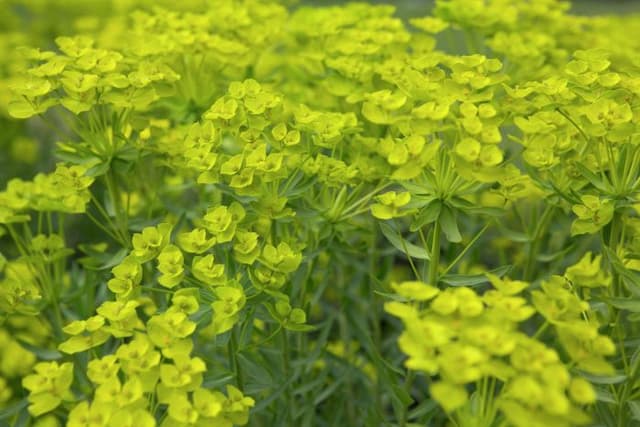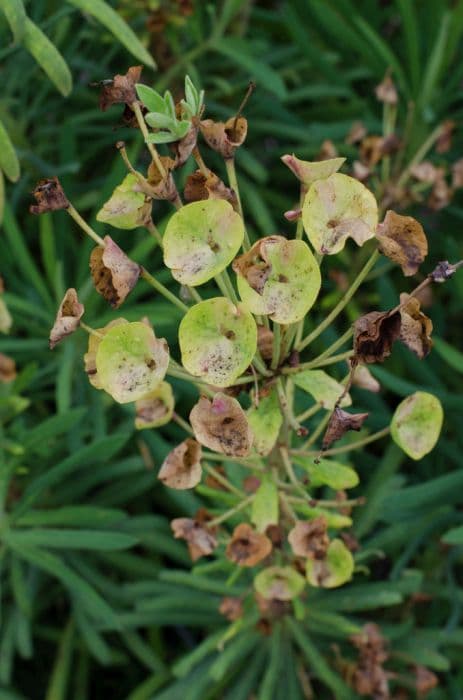Balkan spurge Euphorbia oblongata

ABOUT
E. oblongata is a short-lived, neat, clump-forming herbaceous perennial that's usually grown as an annual. The stem leaves are dark green and no more than 5cm long and 2cm wide. The chartreuse-yellow flowerhead leaves appear in flat heads, 15cm wide, for a long period from spring to autumn
About this plant
 Names
NamesFamily
Euphorbiaceae
Synonyms
Eggleaf Spurge, Oblong Spurge
Common names
Galarhoeus oblongatus, Tithymalus oblongatus.
 Characteristics
CharacteristicsLife cycle
Annuals
Foliage type
Deciduous
Color of leaves
Green
Flower color
Yellow
Height
3 feet (91 cm)
Spread
2 feet (61 cm)
Plant type
Herb
Hardiness zones
7
Native area
Mediterranean
Benefits
 General Benefits
General Benefits- Decorative Appeal: Euphorbia oblongata adds visual interest to gardens and landscapes with its unique shape and bright green foliage.
- Drought Tolerance: This plant is highly resistant to drought, making it ideal for xeriscaping and areas with low water availability.
- Low Maintenance: It requires minimal care once established, reducing the need for frequent watering or fertilizing.
- Pest Resistance: Naturally resistant to many pests, reducing the need for pesticides and promoting a healthier garden environment.
- Soil Erosion Control: The root structure of Euphorbia oblongata can help stabilize soil and prevent erosion.
- Adaptability: It adapts well to a range of soil types and environmental conditions, making it a flexible choice for diverse landscapes.
- Long Blooming Period: The plant produces flowers over an extended period, offering a long-lasting display.
- Wildlife Attraction: It can attract pollinators like bees and butterflies, supporting local biodiversity.
 Medical Properties
Medical PropertiesThis plant is not used for medical purposes.
 Air-purifying Qualities
Air-purifying QualitiesThis plant is not specifically known for air purifying qualities.
 Other Uses
Other Uses- Euphorbia oblongata is sometimes used in floral arrangements due to its long-lasting green foliage and architectural form.
- In some cultures, the latex of the plant has been used as a fish poison to stun fish, making them easier to catch.
- The plant can be used as a natural insect repellent, as some insects dislike the sap's composition.
- Due to its extensive root system, Euphorbia oblongata can help stabilise soil and prevent erosion on slopes.
- Euphorbia oblongata is used in companion planting, it can deter certain pests from more valuable nearby plants.
- The milky sap has been traditionally used to remove warts, though this practice is not recommended due to potential skin irritation.
- Gardeners may use Euphorbia oblongata as a 'filler' plant in garden beds, providing a green backdrop for more colorful annuals and perennials.
- The plant has been employed in pastures to provide a low maintenance ground cover, as it can be quite hardy and drought-resistant.
- Some artists use the sap or crushed leaves to create a natural dye or pigment for their artworks.
- Its distinct shape can inspire patterns and designs in landscape architecture and garden layouts.
Interesting Facts
 Feng Shui
Feng ShuiThe Euphorbia is not used in Feng Shui practice.
 Zodiac Sign Compitability
Zodiac Sign CompitabilityThe Euphorbia is not used in astrology practice.
 Plant Symbolism
Plant Symbolism- Resilience – Euphorbia oblongata is known for its ability to thrive in challenging conditions, symbolizing the capacity to endure and adapt to hardships.
- Protection – The plant's sap can be irritating to the skin and toxic if ingested, which has led to its association with defense and the need to guard against external threats.
- Healing – Despite its toxic sap, certain species of Euphorbia have been used in traditional medicine, representing the dual nature of healing and harm.
 Water
WaterGopher Spurge should be watered when the top inch of soil feels dry to the touch, typically once a week, but this can vary depending on environmental conditions. Gradually add water until it begins to drain from the bottom of the pot, ensuring the plant is not left in standing water. On average, this might equate to around 16-32 ounces for a medium-sized pot every watering session. During the winter months, reduce watering frequency as the plant enters a dormant phase.
 Light
LightGopher Spurge thrives in full sun to partial shade, so place it in a spot where it receives at least 4-6 hours of direct sunlight each day. It can tolerate bright, indirect light but its growth may not be as robust. The best spot for this plant is near a south-facing window or in a garden that receives plenty of morning light and some afternoon shade.
 Temperature
TemperatureGopher Spurge prefers temperatures between 60 to 75 degrees Fahrenheit and can survive minimum temperatures of around 50 degrees Fahrenheit. The ideal temperature range promotes healthy growth. However, avoid exposing the plant to temperatures below 50 degrees Fahrenheit as it could damage the plant or even be fatal.
 Pruning
PruningPruning Gopher Spurge is important to maintain its shape and to encourage bushier growth. Prune the plant in early spring before new growth starts, removing any damaged or overgrown stems. Pruning can be done annually or as needed to control the size of the plant.
 Cleaning
CleaningAs needed
 Soil
SoilEuphorbia oblongata, commonly known as the Gopher Spurge, thrives in a well-draining soil mix with some organic matter, such as a blend of loam, sand, and peat. The ideal soil pH for Gopher Spurge should be slightly acidic to neutral, ranging from 6.0 to 7.0.
 Repotting
RepottingGopher Spurge should be repotted every two to three years to refresh the soil and accommodate the growth of the plant. Care should be taken when handling the plant due to its sap, which can be irritating to the skin and eyes.
 Humidity & Misting
Humidity & MistingGopher Spurge prefers average to dry humidity conditions. It is quite tolerant of low humidity environments, making it suitable for indoor settings where humidity levels are moderate.
 Suitable locations
Suitable locationsIndoor
Place Gopher Spurge in bright light, avoid overwatering.
Outdoor
Plant in sunny spot, well-draining soil, protect from cold.
Hardiness zone
7-10 USDA
 Life cycle
Life cycleEuphorbia oblongata, commonly known as the oblong spurge, begins its life cycle when seeds germinate, typically in the warmth of late spring after the last frost. The seedlings emerge with characteristic paired leaves and gradually develop into mature plants with oblong, green to bluish-green foliage. During its vegetative stage, oblong spurge establishes a strong root system and develops a branching stem structure. Upon reaching maturity, the plant produces small greenish-yellow flowers surrounded by specialized leaves called bracts, typically in late spring or early summer. After pollination, which is often facilitated by insects, the plant forms seed capsules that eventually dry and release seeds for the next generation. Euphorbia oblongata is a perennial herb, so once established, it can survive for several years, entering a period of dormancy during the winter and resuming growth in spring.
 Propogation
PropogationPropogation time
Spring-Summer
Propogation: The common name for Euphorbia oblongata is Spurge, and it is most popularly propagated by seed. This is usually carried out in the spring, providing the warmth needed for germination. To propagate by seed, sow them thinly onto the surface of a well-draining seed starting mix and gently press the seeds into the soil for good contact but do not cover them, as light aids the germination process. Maintain moisture without waterlogging, and provide a steady temperature between 65 to 75 degrees Fahrenheit (about 18 to 24 degrees Celsius). Seedlings often appear within two to three weeks and should be carefully transplanted into individual pots once they are large enough to handle.









